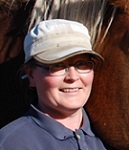Tytti Vanhala

Presentation
As a research BioMedical Analyst (BMA), my primary task is to take assignments from researchers who need molecular genetic lab work done. The level of my involvement in a given project depends on how familiar the researcher is with molecular genetic lab work and how detailed their lab work plan is. At the simplest level I perform the requested lab work with given protocols and hand over results to be analyzed by the researcher. The highest involvement would mean that I would design the whole of the lab work myself for the researcher, finding appropriate protocols and analysis methods to do the work, analyzing the results and producing a report to the researcher. And then anything in between these two extremes.
Another part of my work is going to include having an overall view of the laboratories at our department, including equipment and ordering general laboratory materials within the department. Students and researchers can eventually come to me with practical laboratory related questions.
I will also be working for other labs when needed and when there is need for an extra pair of hands.
Background
I studied biology and graduated with MSc in genetics from the University of Oulu, Finland in 1997. My MSc thesis looked into the population genetics of chicken lines. After that I did my PhD research at the Wageningen University, Netherlands, which I defended in 2004. My topic was population and quantitative genetics of wild barley. From the Netherlands I moved to Scotland and worked as a postdoc at the University of Edinburgh looking into population genetics of wild Antirrhinum. After my postdoc years I worked at Forest Research in Roslin, Scotland. There my main topic was landscape genetics, looking into the effects of forest fragmentation on insect populations (wood crickets in the Isle of Wight and wood ants in Scotland), but I also worked on other topics such as determining species from faeces using RT PCR (is it a fox or a pine marten?), devising and executing a fully ecological experiment on inducing flowering in aspen (it does not want to flower in Scotland under normal conditions), as well as helping out with ecological analyses such as annual report on vegetation cover in a Scottish butterfly reserve. After moving to Sweden in 2010, I continued to work for Forest Research at a distance to finish the projects that I was involved with until I eventually resigned in 2012. I worked then for several years as a freelance researcher doing short projects in pea and cereals. I got a few short appointments also in SLU outside the consultancy, the latest being at the department of Ecology helping out in the lab with molecular genetics of insects.
Thus I have a very diverse and broad background having worked with plants, animals and insects. Molecular genetics – DNA and RNA work - has been the red thread throughout all my appointments and I have loved doing lab work since my practical period in 1993 working with bull sperm and determining kappa casein genotypes from the DNA (that PCR RFLP stuff). That was the first time I performed PCR, when it was still usual to do it in singular 1.5 ml tubes. World of lab work and methods has come far since those times.
Selected publications
Vanhala et al. (2016) Flowering time adaption in Swedish landrace pea (Pisum sativum L.) BMC Genet. 17: 117. https://doi.org/10.1186/s12863-016-0424-z
Watts et al. (2016) Striking the right balance between site and landscape-scale conservation actions for a woodland insect within a highly fragmented landscape: A landscape genetics perspective. Biological Conservation 195: 146-155. https://doi.org/10.1016/j.biocon.2015.12.039
Lopes Pinto F, Vanhala T (2015) Detailed protocol for isolating, cleaning and measuring DNA from Lepidium leaves for RAD sequencing purposes. The Molecular Methods Database 2015/02/05. http://www.molmeth.org/protocol/detailed-protocol-isolating-cleaning-and-measuring-dna-lepidium-leaves-rad-sequencing-0
Vanhala et al. (2014) Population genetics of Formica aquilonia wood ants in Scotland: the effects of long term forest fragmentation and recent reforestation. Conservation Genetics 15: 853-868. https://link.springer.com/article/10.1007%2Fs10592-014-0584-1
Vanhala (2004) Exploring and mapping genetic variation in wild barley. 112 p. PhD thesis. http://edepot.wur.nl/23568
Vanhala et al. (1998) Evaluation of genetic variability and genetic distances between eight chicken lines using microsatellite markers. Poultry Science 77: 783-790. https://doi.org/10.1093/ps/77.6.783